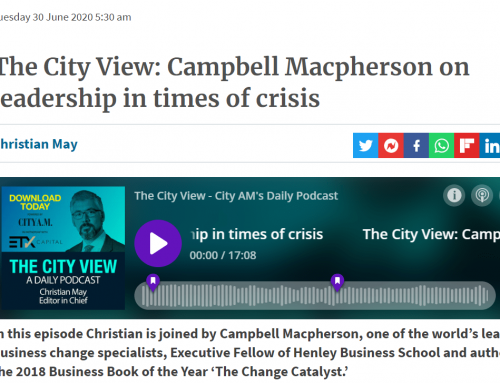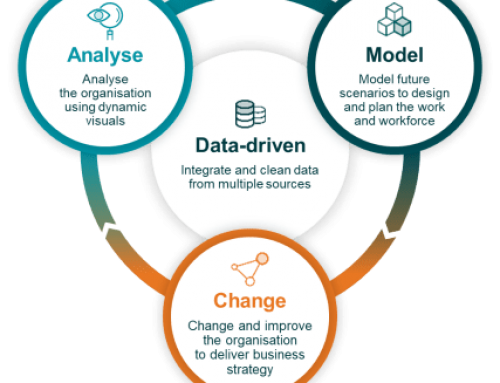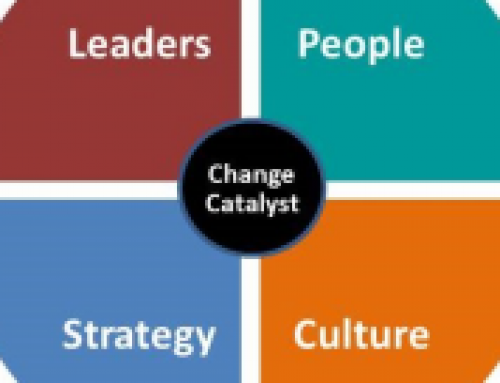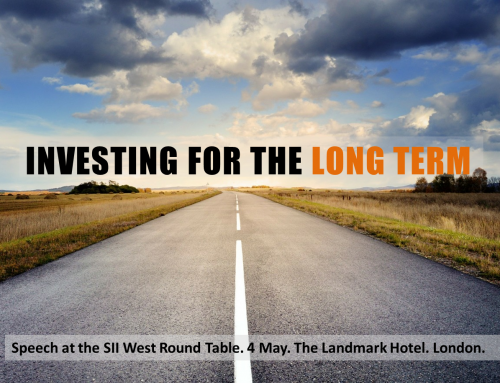As published in the IOD’s Director magazine – June 2017 Edition.
The vast majority of change initiatives fail, as do a similar proportion of strategies, mergers and acquisitions suffer the same fate. How can you ensure that your next change initiative is the one in eight that succeeds? Strategic change expert Campbell Macpherson shares some vital tips.
Change is inevitable. Unfortunately, successful change isn’t. And the reason why change initiatives have such a spectacular failure rate could be neatly summed up by two words: the leadership. The leadership fails to appeal to their people’s emotions. They fail to provide clarity of direction. They don’t understand the implications of the change. They fail to address culture. They become complacent. They allow process to rule outcomes. They inadvertently set the project up to fail. The leadership blinks.
Change is tough. No CEO or leader of change sets out to fail. Yet the vast majority of the time, they do. With the top tips outlined here you will be able to help your people embrace the future and ensure that your next strategy, M&A or change initiative will enjoy outrageous success.
One: Fight for clarity Be crystal clear about what you are trying to achieve – and why. This is surprisingly difficult, but if your people are going to deliver the change you require, they must be completely clear about what the end result needs to be and, more importantly, why it needs to be achieved. In business there is a right reason and a real reason for just about everything. This is particularly true when it comes to change. The ‘real’ reason may not be one that you wish to broadcast (for example the ‘real’ reason for clarifying strategy and aligning people to deliver might be to prepare the business for sale) but it needs to be understood fully by the team leading the change. The ‘right’ reason needs to be as true as the ‘real’ reason and it must be something that will motivate your people to deliver.
Two: Understand the implications “Implications” is the most forgotten word in the business lexicon and yet unintended consequences have scuppered many a new plan. Whether it is a new strategy for the company, a new IT system or an enhancement of a recruitment process, every change comes with its own set of consequences: implications for the team, the department, the organisation and the individuals involved. You should explore as many as possible of these implications in advance, as some of them will be so significant that the strategy itself may need to be altered.
Three: Be obsessed with outcomes Never be fooled by a good, solid process – it is merely an enabler. A process without an outcome is a road to nowhere. I have seen far too many flawless and detailed change processes fail to deliver: ‘The operation was a complete success. Unfortunately the patient died.’ As a change leader you need to be focused to the point of obsession with outcomes – continually checking whether the original outcomes are still valid; continually bringing the project back to what it is trying to achieve; continually probing whether the project is on track to deliver the outcomes the business needs.
Four: Appeal to your people’s emotions As David Cameron amply demonstrated during his disastrous Remain campaign last year, logic alone is not a sufficient motivator. To follow a leader, people need to be motivated emotionally. Our emotions rule our decisions. People voted to leave the EU for emotional reasons – because they had nothing to lose; they wished to be free of the expensive and controlling yoke of Brussels; they wanted to take back control of their borders; or because of the patriotic belief that an unshackled Britain could be Great again. The expert opinions of business leaders and economists that leaving the EU would likely be bad for the economy, increase unemployment, hamper the City, adversely affect inward foreign investment and increase the deficit for many years to come were disregarded. When it comes to change, emotion always wins the day. When it comes to business change, you will need to understand and appeal to the emotions of every one of your people.
Five: Create a change-ready culture An organisation’s culture underpins its success – or failure. The way your people interact with one another drives the way they treat your customers. Culture drives your decision-making processes, your ability to respond to challenges and opportunities, and your ability to change. Your people will need help if they are to embrace change willingly. They will need help to overcome their fear of the unknown, their fear of failure, and/or their fear of being blamed. Enabling this on an organisation-wide scale requires the establishment of an environment where people eagerly look for improvements in the way things are done, are allowed to question the status quo, are encouraged to learn from failure, and are open to new processes, procedures and structures. It requires the establishment of a change-ready culture. The ever-increasing pace of change in the modern business world means that as a leader you must be able to take your organisation in new directions swiftly and decisively when the need arrives.
Six: Identify a Change Catalyst One of the most important ingredients for successfully instigating sustainable change is the identification of a Change Catalyst: someone to guide the organisation to the ultimate delivery of the outcomes the business needs. A Change Catalyst’s strength lies in his/her focus on outcomes. A program or project manager’s strength lies in his/her ability to drive the process. The Change Catalyst is the yin to the project manager’s yang. You will need both.
The Change Catalyst: Secrets to Successful and Sustainable Business Change by Campbell Macpherson is out now, published by Wiley.























